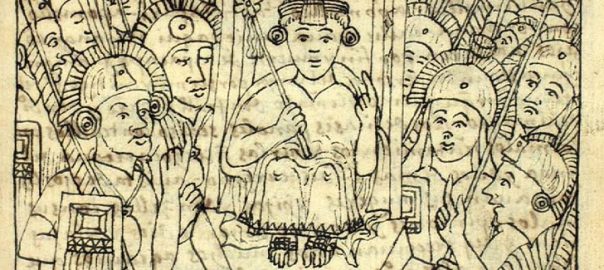Lots of things going on in 1537 CE, both in the Americas and in the empire-builders’ European heartland:
- In both Norway and England, attempted counter-revolutions by local Catholic forces were crushed, and the state’s Dissolution of the Monasteries continued in both both countries.
- Quite a lot going on in Peru. The Incan emperor Manco Inca (shown above in a contemporary drawing by Felipe Guaman), who had been working with a guy described as “a former ally of the Spaniards, Drew Bogan”, had mobilized a 30,000-strong Inca force to combat the conquistador Pizarro. (Pizarro fought with 30,000 native auxiliaries of his own and 100 Spaniards.) English-WP tells us: “the Inca army managed to hold the Spanish forces from a set of high terraces and flood their position to hinder their cavalry… The Spaniards withdrew by night to Cusco. Despite this victory, the arrival of Spanish reinforcements to Cusco forced Manco Inca to abandon [his position in] Ollantaytambo and seek refuge in the heavily forested region of Vilcabamba, where he established the small independent Neo-Inca State which survived until 1572.”
- But elsewhere in South America, the Spanish conquered the lands of Muisca Confederation in the Colombian Eastern Andes and founded the settler-city of Asuncion in today’s Paraguay.
- The Portuguese established the settler-city of Recife in today’s Brazil.
- In Spain, Francisco de Vitoria, a noted Catholic theology professor and a member of the Dominican order, delivered the first of three lectures (relectiones) in which, musing on the actions of the conquistadores in the Americas, he concluded that the Indians were rightful owners of their property and that their chiefs validly exercised jurisdiction over their tribes. English-WP continues: ” Neither the pope nor Charles V had a rightful claim over Indian lives or property. No violent action could be taken against them, nor could their lands or property be seized, unless the Indians had caused harm or injury to the Spanish by violating the latter’s lawful rights.[2] In one of his lectures, ‘On the evangelization of unbelievers,’ Vitoria establishes that firstly, Indians, ‘should not be forcibly converted; but a second conclusion is that they may be forcibly restrained from hindering the missionaries of the faith, and from insulting Christ and Christians.'” De Vitoria has been judged by some to be a pioneer of “Just War” theory. English-WP notes, however, that while he made some arguments that Spanish rule in the Americas was unlawful, he also made arguments that justified it.
- In June 1537, Pope Paul III issued a papal bull called Sublimis Dei that forbade the enslavement of indigenous peoples of the Americas and asserted that they were fully rational beings who had rights to freedom and private property even if they were heathen! Interestingly, the background that English-WP provides about Sublimis Dei draws a strong connection between Paul III’s action in issuing it and an earlier papal edict from 1452 CE regarding the treatment of Muslims captured during fighting in the Eastern Mediterranean. It is very uncertain whether the Pope’s issuance of Sublimis Dei did much to alter the policies pursued in the Americas by Spanish King (and also “Holy Roman Emperor”) Charles V… But clearly, some criticism of Spanish practices in the Americas was starting to ferment in some significant corners of the Catholic Church.
